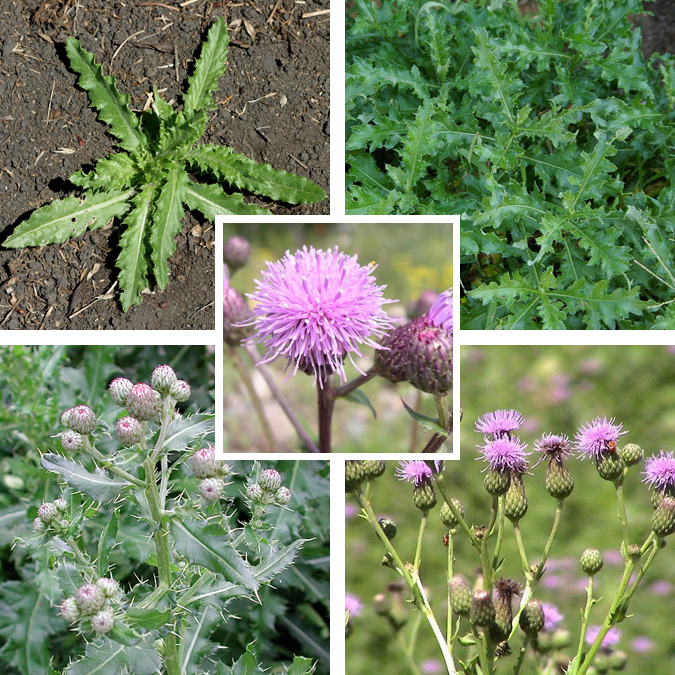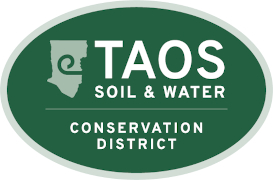Canada Thistle – cirsium arvense

Lookout for this weed and don’t let it get established, because it’s very difficult to get rid of!
Information:
Canada thistle is a perennial that spreads rapidly. It can reproduce from root fragments as well as by seed. To eliminate Canada Thistle, you must exhaust its root system. This requires multiple seasons and treatments within a season.
Identification:
The flowers are purple, less than an inch in diameter, and grow in clusters from 1-5. The leaves are bright green, lance shaped, and irregularly lobed with spiny toothed margins.
- Canada thistle is a creeping perennial that reproduces from vegetative buds in its root system and from seed.
- It is difficult to control because its extensive root system allows it to recover from control attempts.
- Combining control methods is the best form of Canada thistle management.
- Persistence is imperative so the weed is continually stressed, forcing it to exhaust root nutrient stores and eventually die.
Canada thistle is an aggressive, creeping perennial weed that infests crops, pastures, rangeland, roadsides, and noncrop areas. Generally, infestations start on disturbed ground, including ditch banks, overgrazed pastures, tilled fields or abandoned sites. Canada thistle reduces forage consumption in pastures and rangeland because cattle typically will not graze near infestations.
One plant can colonize an area 3 to 6 feet in diameter in one or two years. Canada thistle grows in a variety of soils and can tolerate up to 2% salt content. It is most competitive in deed, well-aerated, productive, cool soils. It usually occurs in 17-to-35-inch annual precipitation zones or where soil moisture is adequate. It is less common in light, dry soils.
Canada thistle develops from seed or vegetative buds in its root system. Horizontal roots may extend 15 feet or more and vertical roots may grow 6 to 15 feet deep. Canada thistle emerges from its root system in mid-to-late spring (late April through May) and forms rosettes.
The greatest flush of root-derived plants occurs in spring, but another flush occurs in fall. A flush can occur anytime during the growing season when soil moisture is adequate. This is particularly a problem when Canada thistle growth is disturbed by tillage or herbicides. This feature can be manipulated to the land manager’s advantage.
Plants that germinate from seed do so at about the same time as root-derived shoots. Seedlings grow slowly and are sensitive to competition, particularly if shaded. Canada thistle seedlings develop a perennial habit (the ability to reproduce from their root systems) about seven to eight weeks after germination.
Reproduction and Spread:
Canada thistle begins to flower in late spring to early summer in response to 14-to-16-hour days. Plants are male or female and grow in circular patches that often are one clone and sex. Female flowers produce a sweet odor and insects readily pollinate different sexed patches up to 200 feet apart.
Canada thistle develops seed sparingly. It may produce 1,000 to 1,500 seeds per flowering shoot. Generally, vegetative reproduction from its root system contributes to local spread and seed to long distance dispersal. Seed may be transported long distances by water, or attached to animals, clothing, farm equipment and other vehicles, and in contaminated crop seed. Also, wind may help disperse seed, but most often, the feathery pappus breaks off, leaving the seed attached to the parent plant to be dispersed by other means. Seed can remain viable in soil up to 22 years, and deep burial promotes survival longevity.
Canada thistle allocates most of its reproductive energy into vegetative propagation. New shoots and roots can form almost anywhere along the root system of established plants (Figure 6). Tillage segments roots and stimulates new plants to develop. Shoots emerge from root and shoot pieces about 15 days after disturbance by tillage. Small root pieces, 0.25-inch-long by 0.125 inch in diameter, have enough stored energy to develop new plants. Also, these small roots can survive at least 100 days without nutrient replenishment from photosynthesis.
Management:
The key principle to Canada thistle control is to stress the plant and force it to use stored root nutrients. Canada thistle can recover from almost any stress, including control attempts, because of root nutrient stores. Therefore, returning infested land to a productive state occurs only over time. Success requires a sound management plan implemented over several years.
Cultural control. Grasses and alfalfa can compete effectively with Canada thistle if their growth is favored by good management. Maintain fertility and, if possible, moisture at optimum levels to favor grass or alfalfa growth. Soil analysis can easily determine fertility needs. Be cautious with nitrogen fertilizers, because excess available soil nitrogen may favor weed growth.
These are essential management steps to ensure optimum desirable plant growth and competition. However, competition alone seldom is effective against Canada thistle.
Mechanical control. Mowing hay meadows can be an effective tool if combined with other management methods. Mowing alone is not effective unless conducted at one-month intervals over several growing seasons. Always combine mowing with cultural and other methods. Mowing at hay cutting stimulates new Canada thistle shoots to develop from its root system.
If a Canada thistle infestation exists in a field that will be rotated to alfalfa, control the weed before seeding alfalfa. Alfalfa is an effective competitor only after it is established. It will not adequately establish in a well-developed Canada thistle infestation. A Canada thistle management system can start with crop or grass competition combined with other management methods, with the field rotated to alfalfa when the management plan ends.
This information was primarily derived from the Colorado State University Extension website. For additional images and information on other management methods, please visit: http://extension.colostate.edu/topic-areas/natural-resources/canada-thistle-3-108/


Leave a Reply